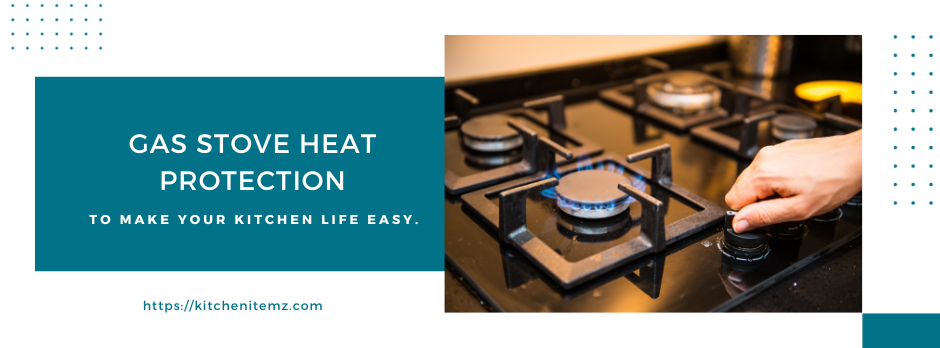
Is a Gas Stove Heat Protection Necessary?
Gas stove heat protection is essential for ensuring safety in the kitchen and preventing accidents or injuries related to hot surfaces. Another important factor is to protect face from kitchen heat.
Here are some standard methods and products used for kitchen cooking gas stove heat protection:
- Pot Holders and Oven Mitts: Thick, insulated materials are used to make oven mitts and pot holders, which shield your hands from hot pans, pots, and ovenware. Choose mitts with heat-resistant materials to ensure adequate protection.
- Silicone Oven Gloves: Silicone oven gloves offer better heat resistance than traditional fabric mitts. They are waterproof and can provide a more secure grip on hot cookware.
- Gas Stove Heat Shields: Heat shields or splash guards can be installed on the wall behind the cooking gas stove to protect nearby surfaces from heat and splatters. Stainless steel or other heat-resistant materials are frequently used to manufacture them.
- Range Backsplashes: Installing a heat-resistant backsplash behind the kitchen stove can protect the wall from heat and make it easier to clean any splatters. Materials like stainless steel or tempered glass are commonly used for this purpose.
- Gas Stove Mats and Trivets: Place heat-resistant mats or trivets on the countertop adjacent to the cooking gas stove. These provide a protective barrier and prevent direct contact between hot cookware and the counter surface.
- Adjustable Heat Resistant Pads: Some products are designed to be placed directly on the kitchen stove to create a heat-resistant barrier. These pads are often adjustable to fit different stove sizes.
- Fire Blanket: In case of a small kitchen fire, having a fire blanket on hand can help smother flames. Make sure it is conveniently accessible in case of emergencies.
- Gas Stove Knob Covers: Stove knob covers are a good idea if you have little children at home in order to avoid burns or burner accidents.
- Ventilation: Ensure that your kitchen has proper ventilation to dissipate heat and cooking odors. A well-ventilated kitchen can also help maintain a more relaxed environment around the kitchen stove.
- Cookware Selection: Choose cookware with insulated handles and lids. This can help prevent burns when handling hot pots and pans.
Always heed the safety instructions that come with your kitchen appliances and accessories from the manufacturer. A safer cooking area is a result of regular maintenance and an understanding of potential risks.
Do I need a heat shield behind a kitchen cooking gas stove?
The need for a heat shield behind a gas stove depends on various factors, including the type of stove, the proximity to combustible materials, and local building codes.
Here are some considerations:
- Manufacturer’s Recommendations: Check the manufacturer’s guidelines and installation instructions for your kitchen cooking gas stove. They often provide specific recommendations regarding clearances and the need for heat shields.
- Local Building Codes: Building codes can vary by location, and some jurisdictions may require a heat shield or have specific regulations regarding the installation of gas stoves. It’s essential to check with your local building department to ensure compliance.
- Proximity to Combustible Materials: If your cooking stove is installed near combustible materials such as cabinets, walls, or other surfaces that could be damaged by heat, a heat shield may be recommended to reduce the risk of fire.
- Type of Cooking Gas Stove: The design and heat output of the kitchen cooking gas stove can also influence the need for a heat shield. High-output stoves or those with a design that directs heat towards the back may require additional protection.
- Personal Safety: Even if not explicitly required by codes or guidelines, it may be a good idea to install a heat shield for additional safety, especially if you have concerns about the proximity of combustible materials.
If you’re unsure about whether a heat shield is necessary for your cooking gas stove, consult with a professional installer or contact the stove manufacturer for guidance. Prioritizing safety and adhering to relevant rules are crucial in mitigating the likelihood of fire dangers.
What is the best material to deflect heat behind a gas stove?
Selecting materials that can tolerate high temperatures and are heat-resistant is crucial when it comes to deflecting heat behind a gas stove.
The following materials are frequently utilized for this purpose:
- Stainless Steel: Since stainless steel is strong and resistant to heat, it is a popular option. It can effectively reflect heat away from the wall behind the stove.
- Aluminum: Aluminum is lightweight and has good heat-reflective properties. It’s commonly used for heat shields and backsplashes behind stoves.
- Ceramic Tiles: Ceramic tiles are heat-resistant and easy to clean. They are commonly used as backsplashes and can be arranged in various patterns for aesthetic appeal.
- Tempered Glass: Tempered glass is heat-resistant and can endure high temperatures. In addition to being a good choice for a stove backsplash, it is too simple to clean.
- Copper: Copper has excellent heat conductivity and can effectively dissipate heat. It also gives the kitchen a hint of refinement. Keep in mind that copper may tarnish over time.
- Fire-Resistant Wallboard: Specialized fire-resistant wallboard or cement board can be used as a heat shield. These materials are non-flammable and made to resist high heat.
When installing a heat deflector behind a cooking gas stove, it’s crucial to follow safety guidelines and local building codes. The material chosen should be installed with the appropriate spacing and fasteners to ensure proper ventilation and safety. Additionally, consider the aesthetics of the material and how well it complements your kitchen design.
How do I reduce the heat on my gas stove?
Reducing the heat on a gas stove depends on the type of stove you have, as well as the specific controls it offers.
The following are general actions you can take:
- Turn the Knob:
- Gas stoves typically have control knobs that let you change the flame’s intensity. Detect the knob for the burner you want to adjust.
- Turn the knob counterclockwise to decrease the flame.
- Check for Specific Settings:
- Some gas stoves have specific settings for low, medium, and high heat. Check if your stove has these settings and adjust accordingly.
- Use Simmer Burner:
- Many gas stoves have a simmer burner designed for low-heat cooking. Locate the simmer burner and use it when you need to reduce heat.
- Use Cookware Wisely:
- The size and material of the cookware can affect heat distribution. Smaller pots and pans may receive more intense heat. If necessary, think about using a larger or other kind of pan.
- Adjust the Airflow:
- Some gas stoves have air adjustment controls. If your stove has these controls, you can use them to regulate the air-to-gas ratio, which can affect the flame intensity.
- Clean the Burner:
- Heat may not be distributed evenly by a filthy burner. Clean the burners regularly to ensure proper heat control.
- Consult the Manual:
- If you’re unsure about the specific controls on your gas stove, refer to the user manual that came with the appliance. It ought to include comprehensive instructions on how to use and modify the heat settings.
Remember always to follow safety guidelines and exercise caution when adjusting the heat on your gas stove. It is recommended that you refer to the manufacturer’s instructions or get help from a professional if you have any questions or are not familiar with the settings on your stove.
Alternatively you can use an induction cooker.


